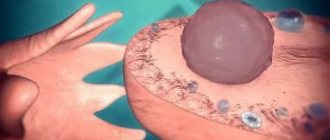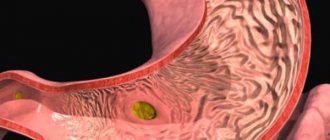Probably everyone is familiar with pain. This is a signal from the body about a certain danger, characteristic of many pathological conditions. For parents whose child is ill, it causes anxiety, and therefore should be the subject of an in-depth examination. Particularly incomprehensible are cases when symptoms from the respiratory and abdominal organs are simultaneously observed. Sore throat, combined with abdominal pain, is a fairly common occurrence in pediatrics. And before taking any measures, you should understand what led to this condition.
Causes and nature of asymmetric sore throat
Let's start with the fact that in anatomy there is no such thing as a “throat”. What we call the throat is the oropharynx, which passes into the esophagus from the digestive system and into the larynx from the respiratory system. In addition to these natural “pipes,” there are many formations that can be a source of painful impulses.
A one-sided sore throat is purely psychologically perceived by a person as more unpleasant, since everyone is accustomed to the fact that pain that occurs when swallowing is always symmetrical. Usually, when we drink water or swallow food, the pain seems less severe.
What are the most common diseases that can cause asymmetric pain? Let us list the most well-known pathological conditions that can lead to disruption of the functioning of the oropharynx, and briefly evaluate the possibility of asymmetric localization of painful impulses.
Acute tonsillitis, or sore throat
It seems like everyone had tonsillitis in childhood. It can be catarrhal, follicular, lacunar. It is possible for a sore throat to occur both with a disturbance in general well-being and against a background of normal temperature. Any form of pathology is characterized by symmetrical pain in the throat. One of the tonsils may be slightly more painful than the other, but a significant difference is still unusual for tonsillitis.
Most often, the patient is bothered by the following symptoms:
- severe pain in the throat when swallowing;
- high fever, joint pain, malaise, headaches;
- hyperemia, swelling and enlargement of the tonsils;
- the presence of plugs of pus on the surface of the tonsils;
- lymphadenitis - enlargement and pain of regional lymph nodes.
In most cases of classic sore throat, it is impossible to say that the throat hurts on one side. Of course, if one of the tonsils is not removed. Such cases happen, but not often. For example, during a tonsillectomy the patient felt unwell and the removal of the second tonsil had to be postponed. But then this situation is completely understandable and does not pose any danger. Read more about sore throat →
Pharyngitis
This is an inflammation of the oropharyngeal mucosa. Pharyngitis is one of the most common diseases in the practice of an ENT doctor. The main symptom is pain when swallowing, including an “empty” swallow, looseness and hyperemia, swelling of the posterior pharyngeal wall. Swelling with banal catarrhal pharyngitis will be symmetrical; to do this, just look in the mirror with your mouth open.
If the pain is localized on one side, then this is a reason to contact an otolaryngologist. It doesn’t matter whether your throat hurts on the right side or the left. Asymmetry indicates that a focus is emerging that is different from general inflammation, and moreover, that the focus is lateralizing.
It should be explained what this means. In the pharynx, which is a mobile formation, there is a very loose submucous membrane, prone to swelling. Therefore, with a common cold, hypothermia, or flu, a lot of symptoms arise - tickling, tickling, and pain - but they are all located in such a way that a person does not separate the direction of the symptoms.
If a distinct lateral projection of pain appears, for example, a sore throat occurs on the right side, this may mean the following:
- the appearance of a purulent focus spreading into the submucosa and deeper (abscess);
- the presence of a specific infection.
In this case, we can talk, for example, about tuberculosis. Sometimes an example is given of the primary period of syphilis, when a hard chancre is located on the back wall of the pharynx. But in this case, there is no pain in the throat on the left side or only on the right. With syphilis, you can see a chancre, but it almost never hurts, since this is the site of introduction of pallidum treponema, and there is no inflammatory process in it. But the regional lymph nodes (posterior cervical, submandibular) will react.
Laryngitis
If the process spreads below the pharynx, then inflammation of the larynx, or laryngitis, occurs. Here we are also talking about the mucous membrane. The main symptom of acute and chronic laryngitis is hoarseness of voice (dysphonia) or its complete loss (aphonia). Typically, all other symptoms, such as burning or foreign body sensation, do not cause the lateral sensation.
But with laryngitis, hyperemia and thickening of the vocal cords occur. If, for example, a hemorrhage occurs in one of the ligaments, and its swelling is greater than that of the neighboring one, this can cause severe pain on the side. A “side” pain in the throat may also occur when nodules appear on the ligaments. They are formed under significant vocal load, for example, among singers and teachers, and the pain indicates an exacerbation of chronic laryngitis.
Of course, speaking of specific syphilitic laryngitis, when ulcers and plaques occur, there can also be an arbitrary lesion. It is then, during the period of secondary fresh or recurrent syphilis, that a situation arises when an atypical pain syndrome is disturbing for a long time, and without connection with hypothermia.
Focal ulcers, or abscesses
Perhaps the most urgent pathology is the appearance of a retropharyngeal and peripharyngeal abscess. It is with these limited purulent foci that a sharply asymmetrical pain in the throat appears. Swallowing is difficult or impossible. The mouth may be full of saliva, which simply flows out. It is also difficult to open the mouth, as a reflex spasm of the masticatory muscles, or trismus, occurs.
Upon examination, a swelling dome of the mucous membrane is noticeable, sharply tense and edematous. Urgent hospitalization is required in a specialized department, where the abscess will be opened and antibiotics will be prescribed. This will immediately lead to improved health.
Diseases of the middle ear and eustachian tube
Everyone knows that with otitis media there are “shooting” pains in the ears. There are auditory tubes that equalize the air pressure in the ear and throat. Their openings open into the pharynx, and with pharyngitis, one of the auditory tubes or both may become inflamed. Then pain occurs on the outside of the throat, also associated with swallowing, which extends to the temporal regions.
Injuries
Soft tissue injuries may well be a source of unilateral pain. The classic cause is accidental ingestion of a spicy fish bone. As a rule, it gets stuck in one of the pharyngeal pockets, can scratch the mucous membrane, infect it, and then deep pain occurs. There is also a foreign body sensation that may be constantly present.
In addition, you can burn the mucous membrane thermally, when eating hot food, or chemically, when vomiting, when gastric juice is erupted. With injuries, the general condition usually does not suffer, and patients can name the cause of the pain.
Oncological causes
The most common diseases include cancer of the lip, tongue and larynx. If a middle-aged person, an experienced smoker, has a chronic sore throat on one side, its causes may lie in a malignant neoplasm of the larynx. It often develops after a long period of chronic laryngitis, against the background of altered laryngeal mucosa.
In addition to one-sided pain, the first signs of cancer are:
- progressive change in voice, up to aphonia;
- the appearance of a space-occupying lesion in the neck;
- if a tumor grows into the lumen of the larynx, restrictive respiratory failure occurs - an obstruction to air flow;
- in the later stages, compression of the esophagus by the tumor occurs, dysphagia occurs - swallowing disorders - first there are difficulties when swallowing solid foods, and then liquid ones.
Of course, other signs of malignant neoplasms will be noticeable: cachexia, anemia, decreased ability to work, pallor, sallow complexion.
Infections
As a rule, most infectious diseases (influenza, parainfluenza, infectious mononucleosis) that affect lymphoid and glandular tissue do not cause unilateral damage. And even if at first the throat hurts only on the right or left, at the height of the illness this feeling is lost.
And only if we are talking about diphtheria of the pharynx, in which dense films are formed that leave behind bleeding marks, one-sided pain can occur. But it is not a diagnostic sign. The doctor is interested in the picture in the pharynx and the nature of the plaque: these are dense gray-white films that are sharply outlined, difficult to separate, and bleeding wounds remain underneath them.
Other reasons
Do not forget that many other diseases can present a picture where the throat hurts on one side when swallowing, during movement and physical activity, or at rest.
Such pathologies include:
- acute attack of ischemic heart disease (angina) - pain radiates to the left side of the throat, not associated with swallowing;
- caries and pulpitis of angular molars;
- basal meningitis and sinus thrombosis;
- glossopharyngeal neuralgia;
- acute leukemia.
Even a severe deficiency of ascorbic acid, or scurvy, can cause symptoms such as ulcerative-necrotic lesions of the oral cavity and oropharynx, accompanied by pain and bleeding.
Tumors
Tumors are divided into benign and malignant. Of the benign tumors, only large adenomas can make swallowing difficult and cause some pain. Malignant neoplasms necessarily in their development come to the stage of periodic or constant pain. Most often, tumors grow from the tonsil and soft palate. Less often - from the back wall of the pharynx.
- Tumors of the epithelium (epitheliomas) begin with superficial ulceration, then give regional lymphadenitis with a wooden density of nodes fused together. As it progresses, the depth and extent of the ulcer increases, and pain increases with a characteristic reflection in the ears.
- Lymphosarcoma causes swallowing, breathing and pain disorders.
- Reticulosarcoma is similar to lymphosarcoma, but differs in earlier metastasis.
- Of the external tumors, thyroid cancer deserves attention, which also causes difficulty in painful swallowing, a sensation of a foreign body in the lower parts of the pharynx, and neck pain. As the tumor grows, it makes breathing difficult, causing shortness of breath and coughing, as well as swelling of the neck and hoarseness of the voice.
- Also, with lymphomas (symptoms), a sensation of a lump in the throat and difficulty swallowing may occur.
First aid for pain
The most important thing is to never try to self-prescribe antibiotics or open a suspicious lesion. The only thing that can be done is to rinse your mouth with a warm antiseptic solution (Furacilin, Chlorhexidine) and suck on special lozenges.
If there is severe malaise and fever, you need to take antipyretic drugs and call a doctor. For the purpose of pain relief, for example, with ulcerative-necrotic lesions, you can use a spray of local anesthetic - lidocaine.
Which doctor should I consult if my throat hurts on one side?
If you suspect an infectious disease, or are worried about high fever and malaise, you need to call a therapist at home. Signs of infection are usually an accompanying cough or runny nose, preceded by hypothermia.
If pain occurs against the background of normal health, you need to go to an otolaryngologist. He can make a diagnosis and, most importantly, identify the source of pain if it is not visible, for example, he will perform a laryngoscopy.
How to treat a throat if it hurts to swallow
For different etiologies of the disease, certain medications are suitable. For example, for a runny nose or inflammation of the larynx, anti-inflammatory medications are well suited; in difficult cases, after complications, antibiotics may be prescribed. Mild forms of illness can be treated with traditional recipes. A sore throat is a symptom of an underlying disease, so treatment methods will depend on the underlying cause, which must be determined by the doctor. The treatment regimen is prescribed individually.
Swallow saliva or food
How to treat a sore throat in this case depends on the nature of the disease. First, you can use antibiotic-free lozenges, lozenges containing phenol, for example, Strepsils, Grammidin, Hexoral. These medications contain essential oils, have an analgesic effect in the throat area, and have a healing effect against inflammatory processes in the pharynx mucosa. Lollipops must be sucked for 10-15 minutes, then do not drink anything for 2 hours, do not gargle, or inhale. You cannot eat more than 5 sweets per day.
Inhalers, sprays Kameton, Hexoral Spray, Ingalipt. These effective drugs have an analgesic, antiseptic effect, relieve acute attacks of pain, soothe dry cough, and facilitate swallowing. During use, it is necessary to direct the inhaler tube as accurately as possible to the inflamed area and press the valve twice. The inhaler should be used 6-7 times a day.
- Carrot caviar for the winter - how to cook at home using step-by-step recipes with photos
- 3 important changes in the rules for assigning pensions and paying pension savings
- Gymnastics for the eyes according to Zhdanov
Rinsing can be done using home remedies (herbs, honey, salt and soda) or using ready-made solutions, for example, Aqualor throat, Lugol solution with glycerin, Laripront. These products have mucolytic, antimicrobial properties; gargling helps reduce pain, red throat, and other symptoms of the acute phase of the pathology. They must be taken in proportions according to the instructions; the solution must be warm (hot or cold is not suitable). It is necessary to rinse every 2 hours for 5-10 minutes.
No temperature
In some pathologies, swallowing becomes painful, but the body temperature does not increase. Taking pills and other medications are prescribed depending on the pathology that caused this symptom:
- When treated with medications, antiviral agents are prescribed, for example, Anaferon, Arpetol, Groprinosin. In case of complications or a complex course of the disease, antibacterial drugs may be needed: Clindamycin, Azithromycin, Ceftriaxone. The use of these medications must be agreed upon with the attending physician.
- Candidal pharyngitis, which is accompanied by fever, is rarely treated with antifungal agents, for example, Fucis, Mikosist, Fluconazole, Nystatin.
- Be sure to gargle if it hurts to swallow. This procedure will stop the spread of infection and relieve local symptoms. Use Chlorophyllipt, Iodinol, Chlorhexidine, chamomile infusion, water-salt solution, and a weak solution of potassium permanganate for rinsing.
Cough and painful to swallow
Such symptoms are inherent in all infectious and viral diseases that cause inflammation of the throat and irritation of the mucous membrane. Therapy for such pathologies coincides with the methods described above, which include:
- anti-inflammatory drugs;
- antiseptic medications;
- sprays, inhalers;
- solutions, decoctions for rinsing.
Treatment
It makes no sense to talk about the treatment of sore throat in general terms without knowing anything about the causes.
All we can say is that sometimes treatment can be very quick and involve puncturing the abscess with a scalpel. If there is a peripharyngeal abscess and the throat hurts on the left side, then after the puncture the patient’s head is also turned to the left so that the pus does not enter the larynx and esophagus. As a rule, the patient already feels well the next day.
For laryngitis, treatment involves voice rest, inhalation and medication. For influenza, the basis is detoxification, antiviral therapy and prevention of the development of a secondary bacterial infection. And in case of ulcerative lesions due to scurvy, only parenteral administration of ascorbic acid and the use of reparants that are used to lubricate the pharynx will help: methyluracil ointment, Actovegin gel, sea buckthorn oil.
Why does my palate hurt?
We can list the following reasons why the upper palate in the mouth may hurt:
Diseases that cause damage to the oral mucosa, which appear after the introduction of pathogenic microorganisms, also affect the condition of the palate and its area. Stomatitis, in which erosive lesions appear on the palate, can have a different etiology, caused by the herpes virus, exacerbation of the activity of Candida - a fungal culture, staphylococci and streptococci.
When to see a doctor?
A visit to the dentist is necessary if the following symptoms are observed in the oral cavity:
- the sensitivity of the mucous membrane is lost and taste sensations are reduced;
- it hurts to chew, and during swallowing something prevents you from pushing the food further;
- the oral mucosa is swollen, bleeding, gums hurt and swell;
- teeth begin to crumble - regardless of age and condition;
- erosive lesions appear on the palate;
- If you run your tongue along the mucous membrane, you feel nodules or areas with a changed structure.
How to treat palate pain?
If the mucous membrane is inflamed inside the mouth, from above, then it is necessary to first establish the causes of the pain. Treatment for pain in the palate of the mouth is carried out each time according to an individual therapeutic regimen, taking into account the symptoms that have arisen and after identifying the pathogen.
For oncological diseases, treatment is only specific and is carried out by an oncologist. A referral to him is usually given by a dentist, who is required to be contacted in case of inflammatory processes that occur in the oral cavity.
When there is confidence that the problems are caused by the introduction of infectious flora, stomatitis can be treated according to the following therapeutic regimen - of course, adjusting the use of medications depending on the pathogen that caused the disease.
- The oral cavity is treated with antiseptics. To do this, you can rinse your mouth with medications and folk remedies. Used: "Rotokan", "Chlorhexidine", "Furacilin", infusions: chamomile, oak bark, centaury, eucalyptus, propolis;
- For severe pain, anesthetics are used - currently they are produced in sprays. The most commonly used are: Hexoral, Lidocaine Asept, Benzocaine;
- Convenient forms of anti-inflammatory drugs are gels. "Cholisal" has no age restrictions; "Lidochlor" instantly relieves pain; "Kamistad" is an effective anti-inflammatory drug that contains only natural ingredients.
For stomatitis of viral etiology, ointments are used: oxolinic, tebrofen and the drug "Acyclovir".
A fairly wide range of products that stop the activity of Candida:
- Viferon ointment, nystatin ointment and Clotrimazole cream;
- "Fluconazole";
- "Diflucan";
- borax with glycerin;
- pimafucin ointment.
Traumatic, bacterial and aphthous stomatitis is treated with the following drugs:
- sprays: “Propasol”, “Chlorophyllipt”, “Tantrum Verdi”, “Bioparox”;
- ointment: Clobetasol;
- means for applications - “Lugol” or “Iodinol”.
In acute cases, hormonal therapy and treatment with general antibacterial drugs are used.
To speed up tissue regeneration, restore the sensitivity of the mucous membrane of the palate and the functions of the epithelium, vitamin and mineral preparations and immunomodulators are used.
The oral mucosa is sensitive to pathological processes occurring in the body, therefore, when it becomes inflamed, it is always necessary to analyze what diseases the pathological manifestations may be associated with, and consult a doctor to identify the causes.
The palate in humans is an important component of the oral cavity, which is a special partition for separating the upper respiratory tract, nose and oral cavity.
Moreover, there is the possibility of successfully reproducing sounds, since it is part of the articulatory apparatus. The palate is divided into two parts: soft and hard. Regardless of which area is affected by pain, it is extremely important to contact an experienced physician who will conduct a diagnosis, make an accurate diagnosis, and understand what to do. Remember that delay is impossible, since you must rule out a serious disease. Determining the cause and treatment of pain in the roof of the mouth is the task of an experienced physician.
Prevention
Perhaps, methods for preventing pain in the oropharynx and larynx do not depend on which side the pain is localized on. If you avoid hypothermia and increase your immunity, you can reduce the frequency of colds.
If you do not strain your vocal cords and do not be in a dusty atmosphere, you can avoid laryngitis. Promiscuous sexual intercourse can lead to chlamydia and syphilitic lesions, and constant smoking and the presence of chronic pathology of the vocal apparatus can lead to cancer.
In conclusion, it must be said that whatever the cause of a sore throat, you should never rely on your own strength - you need to turn to specialists. Only in the most common situation, when a sore throat does not cause concern and occurs against the background of a common ARVI, can you treat yourself.
Inhalations with medicinal solutions and decoctions of medicinal plants - calendula and chamomile are used, and salt rinsing is indicated to relieve swelling. It is recommended to drink plenty of vitamins, as well as take antiseptic lozenges and chewable tablets. If treatment is carried out in a timely manner, you will not be at risk for many of the conditions described in the article.
Author: Stanislav Pogrebnoy, doctor, especially for Moylor.ru
When to see a doctor if your palate and tongue hurt
If you know for sure that you scratched your palate with crackers, fish or meat bones and that the pain is caused by this, you do not need to see a doctor. Local treatment with traditional medicine is sufficient. This could be rinsing with decoctions of medicinal herbs, using sea buckthorn oil, etc.
As a rule, thermal burns of mucous membranes caused by hot food do not require special treatment. In this case, the palate and tongue in the mouth hurt, and the damaged tissues simply need time to recover on their own. However, chemical burns can only be treated in a hospital; in any case, they require mandatory consultation.
Self-medication for palate pain is unacceptable. It is necessary to relieve pain in the process of complex treatment of the underlying disease
Pain from the diseases listed above should be relieved in the process of comprehensive treatment of the underlying illness. Even if a person is well acquainted with the manifestations of stomatitis, he will not be able to independently determine its nature - fungal or viral, and the choice of antiseptic drugs for treatment depends on this.
To get rid of oropharyngeal infections, antibiotics are needed, and you should not prescribe them yourself. For a person without medical education, the pain in the palate with tonsillitis and tonsillitis is the same, but different antibacterial drugs may be required.
If you are worried exclusively about pain in the palate, not accompanied by other symptoms of inflammatory viral diseases, then your first consultation should be with a dentist. He will either prescribe treatment or refer you to another specialist - otolaryngologist, oncologist, infectious disease specialist, etc.
Pain in the palate can be a consequence of mucosal injury or a symptom of a serious illness. It should only be treated by a doctor.
The palate of a person is located in the oral cavity. This is a horizontal partition that separates the cavity of the upper respiratory tract - the nose - from the oral cavity. It is involved in the process of sound reproduction - it is part of the articulatory apparatus.
The palate consists of a soft and hard part. The hard part is the anterior section, which is covered with mucous membrane. The soft palate hangs over the base of the tongue and is located along the posterior bony wall of the convex arch, which divides the nasopharynx into 2 parts.
Painful sensations often occur in the soft part, and the palate can hurt both when swallowing and at rest.











